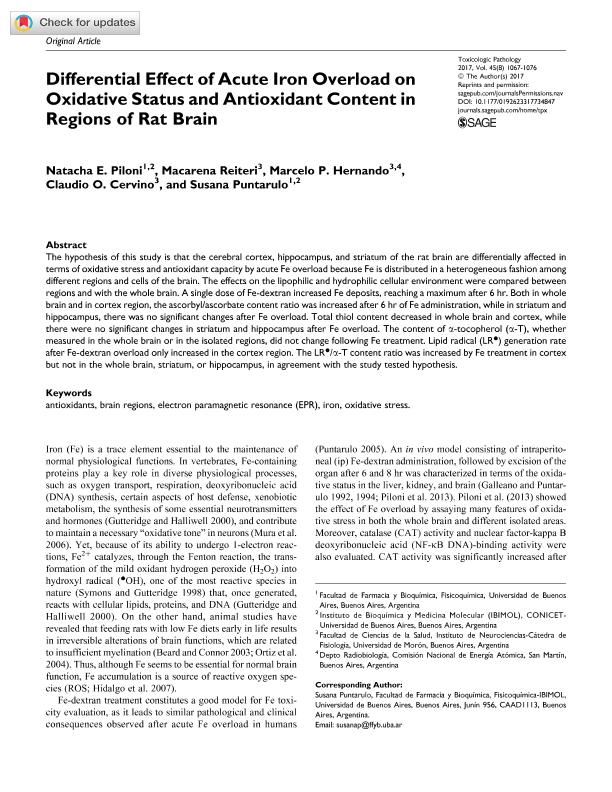Artículo
Differential Effect of Acute Iron Overload on Oxidative Status and Antioxidant Content in Regions of Rat Brain
Piloni, Natacha Estefanía ; Reiteri, Romina Macarena
; Reiteri, Romina Macarena ; Hernando, Marcelo Pablo
; Hernando, Marcelo Pablo ; Cervino, Claudio O.; Puntarulo, Susana Ángela
; Cervino, Claudio O.; Puntarulo, Susana Ángela
 ; Reiteri, Romina Macarena
; Reiteri, Romina Macarena ; Hernando, Marcelo Pablo
; Hernando, Marcelo Pablo ; Cervino, Claudio O.; Puntarulo, Susana Ángela
; Cervino, Claudio O.; Puntarulo, Susana Ángela
Fecha de publicación:
10/2017
Editorial:
SAGE Publications
Revista:
Toxicologic Pathology
ISSN:
0192-6233
Idioma:
Inglés
Tipo de recurso:
Artículo publicado
Clasificación temática:
Resumen
The hypothesis of this study is that the cerebral cortex, hippocampus, and striatum of the rat brain are differentially affected in terms of oxidative stress and antioxidant capacity by acute Fe overload because Fe is distributed in a heterogeneous fashion among different regions and cells of the brain. The effects on the lipophilic and hydrophilic cellular environment were compared between regions and with the whole brain. A single dose of Fe-dextran increased Fe deposits, reaching a maximum after 6 hr. Both in whole brain and in cortex region, the ascorbyl/ascorbate content ratio was increased after 6 hr of Fe administration, while in striatum and hippocampus, there was no significant changes after Fe overload. Total thiol content decreased in whole brain and cortex, while there were no significant changes in striatum and hippocampus after Fe overload. The content of α-tocopherol (α-T), whether measured in the whole brain or in the isolated regions, did not change following Fe treatment. Lipid radical (LR•) generation rate after Fe-dextran overload only increased in the cortex region. The LR•/α-T content ratio was increased by Fe treatment in cortex but not in the whole brain, striatum, or hippocampus, in agreement with the study tested hypothesis.
Archivos asociados
Licencia
Identificadores
Colecciones
Articulos(IBIMOL)
Articulos de INSTITUTO DE BIOQUIMICA Y MEDICINA MOLECULAR
Articulos de INSTITUTO DE BIOQUIMICA Y MEDICINA MOLECULAR
Citación
Piloni, Natacha Estefanía; Reiteri, Romina Macarena; Hernando, Marcelo Pablo; Cervino, Claudio O.; Puntarulo, Susana Ángela; Differential Effect of Acute Iron Overload on Oxidative Status and Antioxidant Content in Regions of Rat Brain
; SAGE Publications; Toxicologic Pathology; 45; 8; 10-2017; 1067-1076
Compartir
Altmétricas



